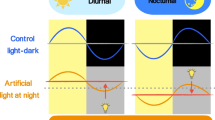Summary
Previous reports by our group and by others showed that the human pineal gland is unresponsive to stress-induced systemic sympathetic activation either during the day or 3 hrs after the beginning of darkness. In the present study, we investigated whether a longer period of dark exposure is required to demonstrate a stimulatory effect of stress-induced sympathetic activation on the human pineal gland. For this purpose, plasma melatonin levels were measured in six healthy men (aged 25–34 yrs) both in resting condition and before and after a physical exercise performed between 02.40 and 03.00 h, 30 min after exposure to bright light (2000 lux). Light exposure lasted from 02.10 h up to 04.00 h. The exercise consisted in bicycling on a bicycle ergometer at 50% of the personal maximum work capacity (MWC) for 10 min, followed by another 10min of bicycling at 80% of the MWC. In the same subjects, plasma melatonin levels were measured also without exposure to light and with no exercise (control dark condition). The results showed that physical exercise, although inducing a rapid and short-term general sympathetic activation (as shown by significant changes in cardiovascular parameters) was able to increase light-depressed plasma melatonin levels only 5 hrs after the end of the stress (p < 0.0001, group X time interaction, two-way ANOVA with repeated measures). These findings suggest that the human pineal gland is responsive to systemic sympathetic activation induced by physical stress in the second half of the dark phase.
Similar content being viewed by others
References
Arendt J, Aldhous M, Bojkowski C, English H, Franey C, Poulton AL, Skene D (1987) Investigations of pineal function in man. In: Reiter RJ, Fraschini F (eds) Advances in pineal research 2. Libbey & Sons, London, pp 223–229
Astrom H, Jonsson B (1976) Design of an exercise test, with special reference to heart patients. Br Heart J 38: 289–296
Boyce P, Kennaway DJ (1987) Effects of light on melatonin production. Biol Psychiatry 22: 473–478
Lewy AJ, Wehr TA, Goodwin FK, Newsome DA, Markey SP (1980) Light suppresses melatonin secretion in humans. Science 210: 1267–1269
Lipton JS, Pettersborg LJ, Steinlechner S, Reiter RJ (1982) In vivo responses of the pineal gland of the Syrian hamster to isoproterenol or norepinephrine. In: Reiter RJ (ed) The pineal and its hormones. Alan R Liss, New York, pp 107–116
Menendez-Pelaez A, Buzzell GR, Nonaka KO, Reiter RJ (1990) In vivo administration of isoproterenol or forskolin during the light phase induces increase in the melatonin content of the Syrian hamster pineal gland without a commensurate rise in N-acetyltransferase activity. Neurosci Lett 110: 314–318
Monteleone P, Maj M, Fusco M, Orazzo C, Kemali D (1990) Physical exercise at night blunts the nocturnal increase of plasma melatonin levels in healthy humans. Life Sci 47: 1989–1995
Monteleone P, Fuschino A, Nolfe G, Maj M (1992 a) Temporal relationship between melatonin and cortisol responses to nighttime physical stress in humans. Psychoneuroendocrinology 17: 81–86
Monteleone P, Maj M, Fuschino A, Kemali D (1992 b) Physical stress in the middle of the dark phase does not affect light-depressed plasma melatonin levels in humans. Neuroendocrinology 55: 367–371
Moore DC, Paunier L, Sizonenko PC (1979) Effect of adrenergic stimulation and blockade on melatonin secretion in the human. Prog Brain Res 52: 517–521
Pangerl B, Pangerl A, Reiter RJ (1990) Circadian variations of adrenergic receptors in the mammalian pineal gland: a review. J Neural Transm 81: 17–29
Parfitt AG, Klein DC (1976) Sympathetic nerve endings in the pineal gland protect against acute stress-induced increase in N-acetyltransferase activity. Endocrinology 99: 840–851
Reiter RJ (1985) Action spectra, dose-response relationships, and temporal aspects of light's effects on the pineal gland. Ann NY Acad Sci 25: 751–752
Reiter RJ (1991) Pineal melatonin: cell biology of its synthesis and of its physiological interactions. Endocr Rev 12: 151–180
Reiter RJ, Vaughan GM, Oaknin S, Troiani ME, Cozzi B, Li K (1987 a) Norepinephrine or isoproterenol stimulation of pineal N-acetyltransferase activity and melatonin content in the Syrian hamster is restricted to the second half of the daily dark phase. Neuroendocrinology 45: 249–256
Reiter RJ, Puig-Domingo M, Guerrero JM, Gonzalez-Brito A (1987 b) Nocturnal increase in the sensitivity of the Syrian hamster pineal gland to isoproterenol is darkness dependent. Proc Soc Exp Biol Med 185: 219–222
Santana C, Menendez-Pelaez A, Reiter RJ, Guerrero JM (1990) Treatment with forskolin for 8 hours during the day increases melatonin synthesis in the Syrian hamster pineal gland in organ culture: the long lag period is required for RNA synthesis. J Neurosci Res 25: 545–548
Steinlechner S, King TS, Champney TH, Richardson BA, Reiter RJ (1985) Pharmacological studies on the regulation of N-acetyltransferase activity and melatonin content of the pineal gland of the Syrian hamster. J Pineal Res 2: 109–120
Vaughan GM (1986) Human melatonin in physiologic and diseased states: neural control of the rhythm. J Neural Transm [Suppl] 21: 199–215
Vaughan GM (1989) Daytime unresponsiveness of the human and hamster pineal to adrenergic stimulation. In: Reiter RJ, Pang SF (eds) Advances in pineal research 3. Libbey & Sons, London, pp 117–122
Vaughan GM, Pelham RW, Pang SH, Loughlin LL, Wilson KM, Sandock KL, Vaughan MK, Koslow SH, Reiter RJ (1979 a) Nocturnal elevation of plasma melatonin and urinary 5-hydroxyindolacetic acid in young men: attempts at modification by brief changes in environmental lighting and sleep and by autonomic drugs. J Clin Endocrinol Metab 42: 752–764
Vaughan GM, McDonald SD, Jordan RM, Allen JP, Bell R, Stevens EA (1979 b) Melatonin, pituitary function and stress in humans. Psychoneuroendocrinology 4: 351–362
Wetterberg L (1978) Melatonin in humans. Physiology and clinical studies. J Neural Transm [Suppl] 13: 289–310
Author information
Authors and Affiliations
Rights and permissions
About this article
Cite this article
Monteleone, P., Maj, M., Franza, F. et al. The human pineal gland responds to stress-induced sympathetic activation in the second half of the dark phase: Preliminary evidence. J. Neural Transmission 92, 25–32 (1993). https://doi.org/10.1007/BF01245159
Received:
Accepted:
Issue Date:
DOI: https://doi.org/10.1007/BF01245159




